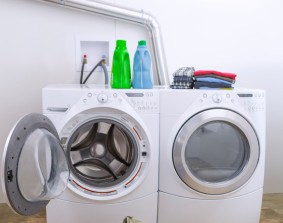Efficient: Efficiency is one of the main reasons consumers are switching to front load washing machines. Most new front loading washers are super efficient when compared to the top loading models of yesteryear, but don’t assume the all models are efficient. The ENERGY STAR rating is an important label to look for because it means that washer uses 50% less Energy and 35% – 50% less Water than non-labeled washing machines. Replacing older washers with ENERGY STAR rated ones could save over $135/year in utility bills.
Stackable: Most front load washers can be stacked with their matched dryers to conserve space. Stacking components can also make the cleaning process easier on the back because clothes can put-in or removed while standing upright as opposed to bending down. Stacking also saves you the additional expense of purchasing pedestals, which cost anywhere from $150 per piece on up.
High Spin Speeds: Front loading washers spin faster than their top loading washer counterparts, helping extract more water before clothing enters the dryer. This helps decrease dry times which help save money and energy in the process. Most Front loading washers offer a minimum of 1,100 RPM spin speed.
Cost More: Front load washers still tend to cost more than front loading models. Prices have come down considerably of the last few years and should continue to do so as Top Load washers begin to phase out. Expect most front load washer to start at minimum of $400 on up. Despite the higher initial expense, increased energy efficiency will offset this cost over time.
Gentle on Clothing: Because Front loading washers don’t use a central agitator (That post found in the middle of most top load models); front load washers are gentler on clothing. This becomes important when trying to prolong garment life and colors.
Top Loading Washers
Top Load WasherCost Less: Top loading washers cost less initially, but will be more expensive over the long haul when lower operating efficiency comes into play.
Capacity: Capacity generally tends to be greater with top loading washing machines, while capacity comes at a premium with front loading washers.
Less Efficient: Utility bills will be more expensive with most top loading washers.
Rough of Clothing: Top loading washers use central agitators to clean clothing. This increases wear and tear on clothing which can attribute to shorter clothing longevity.
Easy Access: Front loading washers require users to bend down to access clothing, while top loading models tend be easier on the back for extended periods of time.
Space Issues: Top loader washers aren’t stackable, making them less appealing in space limited applications.
Source: http://washingmachinereview.com/articles/frontload-washers-vs-topload-washers.html
